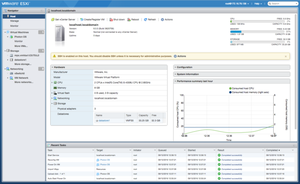VMware ESXi
 |
|
| Developer(s) | VMware, Inc. |
|---|---|
| Stable release |
6.5 (Build 4564106) / 15 November 2016
|
| Platform | i386 (discontinued in 4.0 onwards),x86-64 |
| Type | Hypervisor |
| License | Proprietary |
| Website | vmware |
VMware ESXi (formerly ESX) is an enterprise-class, type-1 hypervisor developed by VMware for deploying and serving virtual computers. As a type-1 hypervisor, ESXi is not a software application that one installs in an operating system (OS); instead, it includes and integrates vital OS components, such as a kernel.
After version 4.1 (released in 2010), VMware renamed ESX to ESXi. ESXi replaces Service Console (a rudimentary operating system) with a more closely integrated OS. ESX/ESXi is the primary component in the VMware Infrastructure software suite.
The name ESX originated as an abbreviation of Elastic Sky X.
ESX runs on bare metal (without running an operating system) unlike other VMware products. It includes its own kernel: A Linux kernel is started first, and is then used to load a variety of specialized virtualization components, including ESX, which is otherwise known as the vmkernel component. The Linux kernel is the primary virtual machine; it is invoked by the service console. At normal run-time, the vmkernel is running on the bare computer, and the Linux-based service console runs as the first virtual machine. VMWare dropped development of ESX at version 4.1, and now uses ESXi, which does not include a Linux kernel.
The vmkernel is a microkernel with three interfaces: hardware, guest systems, and the service console (Console OS).
The vmkernel handles CPU and memory directly, using scan-before-execution (SBE) to handle special or privileged CPU instructions and the SRAT (system resource allocation table) to track allocated memory.
Access to other hardware (such as network or storage devices) takes place using modules. At least some of the modules derive from modules used in the Linux kernel. To access these modules, an additional module called vmklinux implements the Linux module interface. According to the README file, "This module contains the Linux emulation layer used by the vmkernel."
...
Wikipedia
